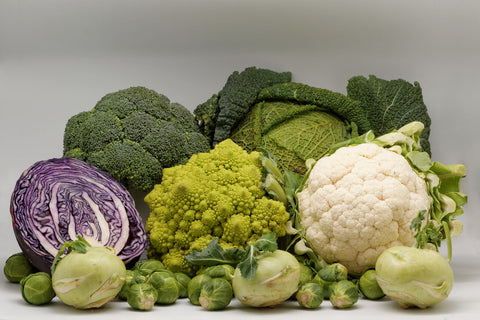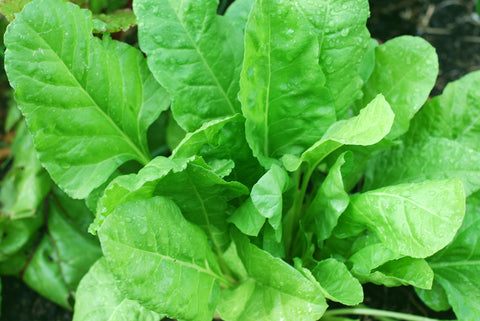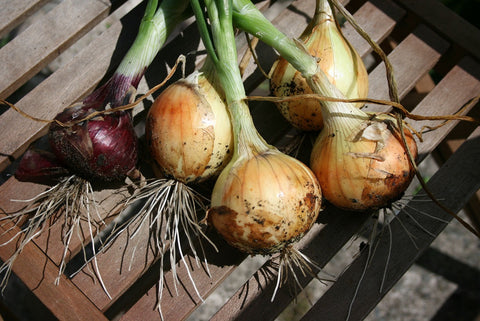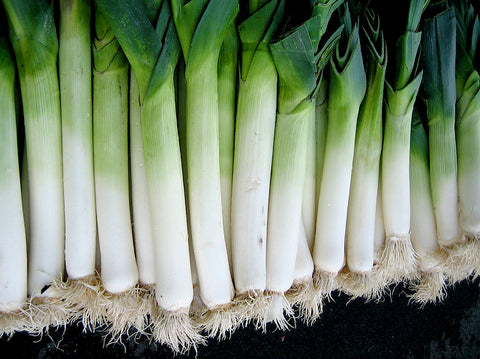Last year we wrote a blog ‘What to Grow In Autumn’ discussing which vegetables are best to plant for the Autumn/Winter seasons ahead. This Autumn, we’re expanding on that blog by showing you how to plant and grow those Autumn/Winter veggies. Here’s how to best plant brassicas, leeks, onions and more in the Vegepod raised garden bed.
Brassicas: Broccoli, Cabbage and Brussel Sprouts

Planting brassicas in Autumn will most likely lead to the heads popping up in late May or early winter. That’s because these brassicas are not your average spinach leaf. It takes time to grow the heads. We advise you get planting now to see results 7 - 8 weeks later.
Planting: For broccoli, cabbage and brussel sprouts, ‘direct-sowing’ works well, as the Vegepod’s container base provides a slightly warmer environment for seed germination. Just plant the seeds (for broccoli, brussels, and cabbage) directly into the soil at a depth that is three times the diameter of the seed.
Spacing:
- For broccoli, plant the seeds 35 to 50 cm apart.
- For cabbage, plant the seeds 50 to 75 cm apart.
- For brussel sprouts, plant the seeds 45 - 60 cm apart.
Sun & Soil: Plant in an open, sunny spot that’s well-composted and well-drained. Brassicas like slightly alkaline soils, so if your potting mix soil is more than a year old, add a handful of limes to keep the acidity at bay.
Compatible plants: Dwarf (bush) beans, beets, celery, cucumber, onions, marigold, nasturtium, rhubarb, aromatic herbs (sage, dill, chamomile)
Incompatible plants: Climbing (pole) beans, tomatoes, eggplants, strawberry, mustard, or climbing beans.
Leafy Greens: Silverbeets and Spinach

These two are great for reliable greens during the cooler seasons.
Planting: Direct sowing is fine to begin in March - place the seeds into the soil at a depth three times the diameter of the seed.
Spacing: Both spinach and silverbeet seeds can be spaced 20 to 30 cm away from each other.
Sun and Soil: We recommend planting seeds of both of these varieties in an area that gets full sunlight. Both veggies prefer well composted soils that are rich and slightly alkaline, with a pH of 6.5 - 7. Again limes can be tossed on old soil to keep it alkaline.
Compatible plants: Both spinach and silverbeet are compatible with broad beans, cabbage, cauliflower, and onion.
Incompatible plants: Spinach is compatible with everything. However, silverbeet can’t be placed near corn, melon, cucurbit (cucumbers, squash, melons, gourds), most herbs, or potatos.
Root Vegetables: Onion & Leeks
When you think of autumn and winter, you think of these classic vegetables going into warm, hearty beef stews for the cold nights ahead. Here’s how to plant Allium varieties, such as onion and leeks.
Onions

Planting: We recommend purchasing a miniature bunch of onion bulbs (often called onions ‘sets’) from a farmers market. Soak the onion sets in water for 15 minutes so you can easily pull the bulbs apart when planting. Plant the bulbs two inches deep into the soil with the bulb sitting on the surface.
Although most onions won’t be ready to harvest until the end of winter, the weaker growing onions can be picked throughout and the shoots serve as an excellent herb-like garnish.
Spacing: Space the bulbs 5 to 10 cm apart.
Sun and Soil: Onions prefer full to partial sun and don’t mind soil that’s slightly acidic.
Compatible plants: Lemon balm, borage, carrots, beets, silverbeet, lettuce, amaranth
Incompatible plants: Peas, beans
Leeks

Planting: Plant at a depth three times the diameter.
Spacing: Because leek seeds are so small, we also recommend using the ‘ruthless horticulturalist technique’ of seed germinating, i.e., dumping a few in every hole and rooting out the weaker shoots once they begin to grow. Again, you can use the weaker shoots as tasty additions to your meal.
Sun and Soil: Plant leek seeds in an area that gets full sunlight. Like almost all vegetables, leeks love well-composted, well-drained soil. Leeks also love a bit of humus added in.
Compatible plants: Onions, celery, carrots.
Angus Stewart’s Top Tips For Autumn/Winter Growing

Liquid Feed Your Winter Crops
Use an organic fertiliser for ‘foliar feeding’. Foliar feeding is where you apply the fertiliser using a watering can over the foliage, so the nutrients get taken up by the leaves as well as the soil underneath.
This will help with the lack of organic matter the soil has at winter time; it will also make sure the leaves don’t suffer from iron deficiencies, which can occur as the leaf tips get cooler. If your leaves are going yellow this is a sign of iron deficiency. Pour liquid fertiliser over first (we recommend worm tea over proprietary blends). If that doesn’t work, we recommend a liquid iron supplement called ‘Iron Chelates’.
Direct Sowing Methods Work Well
Although some say you should grow your seeds in covered pods indoors and transplant them, we don’t think that’s necessary. You can grow crops from seed in the Vegepod. That’s because they’re winter crops, so they’re adapted to a cooler environment anyway. Seedlings from a nursery, however, can actually be damaged as they’ve been contained for too long. Don’t establish seedlings, just choose the right winter crops: alliums, brassicas and certain pea varieties, instead.

2 comments
Thank you for the information on autumn planting, it will be very helpful in propagating in our elevated garden.
Can’t wait to harvest a cauliflower, which out of the pod, are super susceptible to pests. Will plant some nasturtium to aid with getting rid of these too….
Leave a comment